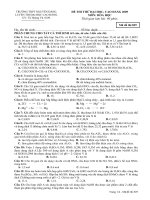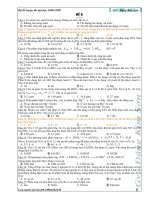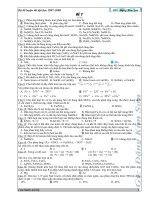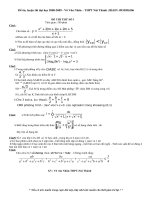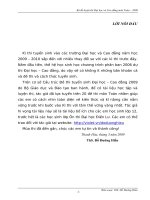Luyen Thi Dai Hoc 2009 Test 17
Bạn đang xem bản rút gọn của tài liệu. Xem và tải ngay bản đầy đủ của tài liệu tại đây (166.98 KB, 6 trang )
<span class='text_page_counter'>(1)</span><div class='page_container' data-page=1>
<b>LUYỆN THI TUYỂN SINH ĐẠI HỌC 2009 </b>
<b>PRACTICE TEST 17 – 09 – 7 – 2009 </b>
<i><b>Questions 1-5. Mark the letter A, B, C, or D to indicate the word that differs from the rest in the position of </b></i>
<i><b>the main stress in each of the following questions</b></i>.
1. A. attractive B. calculate C. outskirts D. similar
2. A. conquest B. physicist C. process D. instrumental
3. A. industrial B. experiment C. accidental D. professor
4. A. actually B. contaminate C. organize D. educate
5. A. mature B. nature C. culture D. measure
<i><b>Questions 6 - 35. Mark the letter A, B, C, or D to indicate the correct answer to each of the following </b></i>
<i><b>questions. </b></i>
6. I'd like to introduce you to Mrs. Thoa, ... husband you used work with.
A. whom B. whose C. which D. who
7.1 may never be able to come back to Vietnam, ... I want to see as much as possible while I am here.
A. although B. unless C. because D. so
62. She didn't mind...her hair wet in the rain.
A. getting B. to get C. in getting D. to have got
8. So far I've only written half of the report, but I - all of it by Saturday.
A. finish B. have finished C. will have finished D. might have finished
9. I wish I...you, but I was short of money myself.
A. have helped B. can help C. would help D. could have helped
10. You've kept us waiting here for two hours. Next time make sure you are ...
A. suitable B. influential C. punctual D. variable
11. In order to... this theory, we carried out a number of experiments.
A. contest B. persuade C. engage D. demonstrate
12. Few young people can start up a new business... first having to borrow money.
A. indeed B. without C. about D. through
13. The view from the window is one of I have ever seen.
A. the finest B. finest C. the finer D. finer
14. Make sure you turn...the television before you go out, but leave one of the lights
A. down - out B. out - over C. up - in D. off - on
15. This report seems interesting in parts, but the last section is ... unrealistic.
A. completely B. sensibly C. consequently D. nervously
16. The view ... our window must" be one of the best anywhere ...the town.
A. in - over B. through – of C. from - in D. down- outside
17...he was feeling very tired, he agreed to walk with me as far as the next village.
A. Since B. So far C. Even though D. As if
18. The...about the date of the meeting was the result of a typing error.
A. confusion B. approval C. dependence D. expression
19...car is out of order so they want to come with us in...
A. His - my B. Their – ours C. Hers - theirs D. Her - your
20. I don't like to go to the cinema twice on...day.
A. such B. same C. the other D. the same
21. I doesn't look like rain but take an umbrella just...it does.
A. so as B. in case C. as if D. so that
22. Though I had given him some good advice on how to act, he didn't listen to me,...?
A. did he B. didn't he C. had I D. hadn't I
23. When I ... into his office at 11 o'clock he...his coffee.
A. will go - will have B. go - has had C. was going - has D. went - was having
24. I didn't realiie...it would take me to get there on foot.
A. how long B. how much C. how far D. so long
25. Jane told me that she...to ring me all morning.
A. has been trying B. had been trying C. will be trying D. has tried
26. If I' you weie coming round to see me this afternoon I...a cake for us.
</div>
<span class='text_page_counter'>(2)</span><div class='page_container' data-page=2>
27. I'm extremely fond...her, too; but even so I'm afraid we can't rely ...her.
A. about - to B. of- on C. for - in D. to - with
28. If it's not on the table, look...the table; it may have fallen...
A. below - through B. at – down C. after - away D. under - off
29. Everyone was surprised to see us because we... to return before the middle of the month.
A. are not expected B. have not expected
C. were not expected D. are not expecting
30. Computers and new methods of communication …….. revolutionize the modern office.
A. have B. to have C. that have D. has
31. The secretary...didn't know where the meeting was.
A. which I talked to B. I talked to C. I talked to her D. whose I talked to
32. ...is extremely dangerous.
A. At very high speeds driving cars B. Cars at very high speeds driving
C. Driving cars at very high speeds D. Cars driving at very high speeds
33. "Shall I take an umbrella ?" - "Yes, you …. . It might rain."
A. 'd rather B. shall C. will D. 'd better
34. Spectators are reminded that it is...to take photographs during the match.
A. prevented B. restricted C. forbidden D. banned
35. After Jessica... her course, she intends to work in her father's company.
A. will finish B. will have finished C. is finishing D. finishes
<i><b>Questions 36 - 45. Read the following passage and mark the letter A, B, or D to indicate the best option for </b></i>
<i><b>each of the blanks. </b></i>
<b>BIRD FLU </b>
There has been a(n) (36).... bird flu in Asia recently. The first (37) …..of avian influenza, better known as
....died two weeks ago in Vietnam and there have been cases reported since in Thailand, and there are pme
suspected cases in Cambodia (38)...
Wild birds are affected by a large number of flu viruses, just as humans id other animals (39) ..., but they
are normally exclusive to birds. If the viruses manage to mutate, they can jump the species barrier and feet
human beings. The first case (40)...someone died was in Hong Kong in 1997.
There are several different forms of bird flu, ranging from mild to very (41) ... infections, which spread
rapidly and kill many of the birds they infect. It is spread by (42) ... birds -- ducks, in particular, which carry
the virus, but aren't killed by it. They can spread the virus to farm birds through (43)...contact or by
contaminating water supplies.
World Health Organization officials have attributed the spread of bird to human contact with the droppings
of infected birds and (44)... <i><b>sanitation</b></i>. There was no evidence at first that the virus spread from person to
person, though there has been a (45)...of this happening be investigated by scientists.
36. A. break-up B. outburst C. outbreak D. breakout
37. A. victims B. casualties C. sufferers D. infector
38. A. also B. too C. either D. as
39. A. do B. are C. will D. does
40. A. where B. when C. which D. in
41. A. strict B. severe C. serious D. heavy
42. A. natural B. wild C. untamed D. untrained
43. A. direct B. straight C. immediate D. square
44. A. awful B. bad C. terrible D. poor
45. A. circumstance B. situation C. case D. form
<i><b>Questions 46 - 55. Read the following passage and mark the letter A, B, C, or D to indicate the best answer </b></i>
<i><b>to each of the following questions. </b></i>
<b>ART AND PHILOSOPHY </b>
</div>
<span class='text_page_counter'>(3)</span><div class='page_container' data-page=3>
Aesthetic questions have been answered in many different ways. The Greek philosopher Plato, for example,
taught that all people are born with knowledge of perfect types - <i><b>archetypes</b></i>. Everything that people perceive
on Earth is a copy of an archetype, and people judge whatever they see, feel, smell, touch, taste by comparing
it to its archetype. A painting of a rose, therefore, should be judged by comparing it to a real rose. The real
rose, after all, is itself a copy of the archetypical rose.
But if Plato's aesthetic ideas are correct, why do people disagree about beauty? For instance, why do some
people consider the paintings of Picasso to be intelligent and beautiful, while others consider <i><b>them</b></i> to be stupid
and ugly? If everyone is born with knowledge of archetypes, then everyone should agree about what institutes
beauty.
Plato's answer to this objection is that although everyone can know archetypes, not everyone does. Only
people who make an effort to use their knowledge of archetypes do. Others are either not aware that they have
this knowledge, or are simply too lazy to develop it.
Many people are dissatisfied with this answer, therefore, there are many aesthetic theories besides Plato's.
People seem to have a need to define; aestheticians have been providing definitions of beauty for over a
thousand years; but they <i><b>have yet to provide</b></i> a definition with which everyone agrees.
46. What does “<b>archetypes</b>” <i>mean? </i>
A. standards B. perfect types C. big types D. round types
47. <i>Which of the following definitions of art does the author seem to use?</i>
A. Art is skilled production.
B. Art is that which is beautiful.
C. Art is the area of human endeavour that requires skill.
48. <i>Which one of the following statements is an example of logical reasoning?</i>
A. Aesthetics is a branch of philosophy, therefore, all philosophers are aestheticians.
B. People are born with knowledge of archetypes, therefore, people can become skillful at making judgments
about beauty.
C. Art is that which is beautiful, therefore, Picasso's paintings are beautiful.
D. Humans can speak, therefore, parrots are humans.
49. <i>According to Plato... </i>
A. An archetype could have many copies.
B. Everything on Earth is perfect.
C. Art can be perfectly beautiful.
D. People should judge a painting of a rose by comparing it to a real rose.
50. <i>Which of the following statements are not objections to Plato's aesthetic idea? (mark as many as are </i>
<i> correct) </i>
A. Art should not be judged by how well it represents its archetype.
B. Not everyone agrees about what is beautiful.
C. It is possible for everyone to agree on what is beautiful,
D. People from different cultures have different ideas about what is beautiful.
51. <i>Which of the following statements could be reasons that there is more than one theory of aesthetics? </i>
A. People do not agree about what beauty is. B. People know little about other cultures than they used to.
C. Everyone agrees with Plato's ideas. D. People are well-informed of Plato’s archetypes.
52. <i>What does them in line 11 refer to? </i>
A. people B. Picasso’s paintings C. others D. aesthetic ideas
53. <i>What is “<b>have yet to provide</b>” in the last line similar in meaning to …</i>
A. have not provided B. have already provided
C. have no longer provided D. have still provided
54. <i>What can be inferred from this passage?</i>
A. Standards of beauty is definitely defined B. Standards of beauty are still on debate.
C. Everyone has the same archetype for beauty. D. People are aware of the same archetypes of beauty.
55. <i>Which of the following is UNMENTIONED in the context. </i>
<i> </i>A. People do not have unanimous opinions of Plato’s ideas.
B. Not all people make use of the knowledge of archetypes.
C. A picture of a rose is a copy of an archetype.
D. Plato has many aesthetic theories.
<i><b>Questions 56 - 62. Read the following passage and mark the letter A, B C, or D to indicate the best answer </b></i>
<i><b>to each of the following questions. </b></i>
</div>
<span class='text_page_counter'>(4)</span><div class='page_container' data-page=4>
cheap. Swedish settlers in Delaware built log cabins as early as the 1630s. In New England, British colonists
built wooden "saltbox houses". Most of the wooden homes of Colonial times could be built with simple tools
and minimal skills.
In the early nineteenth century, the standard wooden house was built with beams set into heavy posts and
held together with wooden pegs. This method of construction was time consuming and required highly skilled
workers with special tools. The balloon-frame house, invented in 1833 in Chicago by a carpenter from
Hartford, Connecticut, used a framework of lightweight lumber, mostly 2x4 and 4x6 inches. This type of
house could be assembled by any careful worker who could saw in a straight line and drive a nail.
This revolution in building was made possible by improved sawmills that could quickly cut boards to
standard sizes and the lower cost of lumber that resulted. There were also new machines that could produce
huge quantities of inexpensive nails. Skeptics predicted that a strong wind would send such houses flying
through the air like balloons and, at first "balloon frame" was a term of derision. But the light frames proved
practical, and wooden houses have been basically built this way ever since.
56. <i>What is the main purpose of the passage? </i>
A. To trace the influence of Swedish and British settlers on American styles of building.
B. To stress the importance of wood as a building material.
C. To compare methods of constructing wooden houses in various parts of the country.
D. To describe a revolutionary technique for constructing wooden houses.
57<i>. According to the passage, where did the inventor of the balloon-frame house originally come from? </i>
A. Connecticut B. Chicago C. Sweden D. Delaware
58. <i>Which of the following questions about the balloon-frame house is not answered in the passage?</i>
A. Where was it invented?
B. What was its inventor's name?
C. What size was most of the lumber used in its framework?
D. In what year was it invented?
59. <i>The author implies that which of the following types of houses required the most skill to produce? </i>
A. The log cabins built by Swedish settlers.
B. Saltbox house
C. Standard wooden houses of the early nineteenth century
D. Balloon-frame house
60. <i>All of the following are factors in the development of the balloon-frame house EXCEPT…</i>
A. The invention of sophisticated tools. B. The production of cheap nails.
C. Improvements in sawmills. D. The falling price of lumber.
61. <i>According to the passage, why was the term balloon-frame (in the passage) applied to certain houses? </i>
A. They could be moved from place to place.
B. They could be easily expanded.
C. They had rounded frames that slightly resembled balloons.
D. They were made of lightweight materials.
62. <i>The word derision in the passage is closest in meaning to …</i>
A. affection B. ignorance C. ridicule D. regret
<i><b>Questions 63 - 70. Mark the letter A, B, C, or D to show the underlined part that needs correction. </b></i>
63. Neither my sisters nor my brother are ready to enter college.
A B C D
64. Can you let the students to continue with this course if he makes up all missed work?
A B C D
65. Whether we leave early or late depends in your schedule.
A B C D
66. The boys should not had made so much noise; I wasn't able to concentrate on my work.
A B C D
67. When he lived in Paris he went to the parties every weekend.
A B C D
68. I asked Peter to stop by the travel agent to get a plane's ticket for me.
A B C D
</div>
<span class='text_page_counter'>(5)</span><div class='page_container' data-page=5>
70. The audience applauded respectively at the end of her speech.
A B C D
<i><b>Questions 71 - 75. Mark the letter A, B, C, or D to indicate the sentence that has the same meaning as the </b></i>
<i><b>original one. </b></i>
71. <i>I was shocked that John failed the entrance exam.</i>
A. I was so shocked that John could not fail the entrance exam.
B. John's failing the entrance exam was shocking me.
C. The entrance exam was failed, and John was shocked to me.
D. That John failed the entrance exam shocked me.
72. <i>The story of their sufferings was painful to listen to. </i>
A. To listen to the story of their sufferings was painful.
B. The story of our sufferings was painful for them to listen.
C. It was painful to listen to the story of their sufferings.
D. Listening to our sufferings made them painful.
73. <i>You can enrich your knowledge by surfing the Internet.</i>
A. Surfing the Internetcan make you know more.
B. You can be rich if you surf the Internet<i>.</i>
C. Surfing the Internetmakes you know less.
D. Surfing the Internetenables you to be rich.
74. <i>So far we have completed fewer than half of the twenty lessons in the same reading book that their class </i>
<i>has almost finished. </i>
A. We have done ten lessons of the book.
B. The book has more ten lessons for us to complete than for their class.
C. The other class has done more than half of the lessons.
D. Fewer than half of the lessons were done by us compared with their class.
75. <i>His reactions are quite unpredictable. </i>
A. People always know how he will react. B. Nobody knows how he is going to react.
C. Everybody can know what his reactions will be. D. He cannot be predicting his reactions.
<i><b>Questions 76 - 80. Mark the letter A, B, C, or D to indicate the best sentence built from the given words or </b></i>
<i><b>phrases. </b></i>
76. <i>Spend / his time / travel / the world / now / write / experiences//</i>
A. He spent most of his time to travel around the world and now to write about his experiences.
B. He spent most of his time travelling around the world for now writing about his experiences.
C. He spent most of his time travelling around the world and now he is writing about his experiences.
D. He spent most of his time travelling around the world and now he has written about his experiences.
77. <i>I / write / Jim / last week / so far / receive / no reply / my letter//</i>
A. I wrote to Jim last week but so far I have received his reply to my letter.
B. I wrote to Jim last week but so far I have received no reply to my letter.
C. I wrote to Jim last week but so far I haven’t received no reply to my letter.
D. I wrote to Jim last week but so far I received no reply to my letter.
78. <i>I / hear / you / buy / house / move / get / promotion//</i>
A. I heard that you bought that house and moved there before your promotion.
B. I heard that you have bought that house and moved there before you get your promotion.
C. I heard that you have bought that house and will move there before you got your promotion.
D. I heard that you had bought that house and moved there before you got your promotion.
79. <i>We / no sooner / leave / house / it / rain// </i>
A. No sooner had we left the house than it began to rain.
B. We have no sooner left the house than it begins to rain.
C. We had no sooner left the house than it begins to rain.
D. No sooner have we left the house than it began to rain.
80. <i>My father / tired / live / city / want / quiet village// </i>
</div>
<span class='text_page_counter'>(6)</span><div class='page_container' data-page=6>
<b>ANSWER KEY TO TEST 17 </b>
<b>1 </b> <b>A </b> <b>9 </b> <b>C </b> <b>17 </b> <b>C </b> <b>25 </b> <b>D </b> <b>33 </b> <b>D </b> <b>41 </b> <b>C </b> <b>49 </b> <b>A </b> <b>57 </b> <b>A </b> <b>65 </b> <b>C </b> <b>73 </b> <b>A </b>
<b>2 </b> <b>D </b> <b>10 </b> <b>D </b> <b>18 </b> <b>C </b> <b>26 </b> <b>A </b> <b>34 </b> <b>C </b> <b>42 </b> <b>B </b> <b>50 </b> <b>A </b> <b>58 </b> <b>B </b> <b>66 </b> <b>B </b> <b>74 </b> <b>C </b>
<b>3 </b> <b>C </b> <b>11 </b> <b>C </b> <b>19 </b> <b>A </b> <b>27 </b> <b>B </b> <b>35 </b> <b>D </b> <b>43 </b> <b>A </b> <b>51 </b> <b>A </b> <b>59 </b> <b>C </b> <b>67 </b> <b>C </b> <b>75 </b> <b>B </b>
<b>4 </b> <b>B </b> <b>12 </b> <b>D </b> <b>20 </b> <b>C </b> <b>28 </b> <b>C </b> <b>36 </b> <b>C </b> <b>44 </b> <b>D </b> <b>52 </b> <b>B </b> <b>60 </b> <b>A </b> <b>68 </b> <b>C </b> <b>76 </b> <b>C </b>
<b>5 </b> <b>A </b> <b>13 </b> <b>B </b> <b>21 </b> <b>B </b> <b>29 </b> <b>C </b> <b>37 </b> <b>A </b> <b>45 </b> <b>C </b> <b>53 </b> <b>A </b> <b>61 </b> <b>D </b> <b>69 </b> <b>A </b> <b>77 </b> <b>B </b>
<b>6 </b> <b>B </b> <b>14 </b> <b>A </b> <b>22 </b> <b>D </b> <b>30 </b> <b>A </b> <b>38 </b> <b>D </b> <b>46 </b> <b>B </b> <b>54 </b> <b>B </b> <b>62 </b> <b>C </b> <b>70 </b> <b>B </b> <b>78 </b> <b>D </b>
<b>7 </b> <b>D </b> <b>15 </b> <b>D </b> <b>23 </b> <b>B </b> <b>31 </b> <b>B </b> <b>39 </b> <b>B </b> <b>47 </b> <b>B </b> <b>55 </b> <b>D </b> <b>63 </b> <b>A </b> <b>71 </b> <b>D </b> <b>79 </b> <b>A </b>
<b>8 </b> <b>A </b> <b>16 </b> <b>A </b> <b>24 </b> <b>A </b> <b>32 </b> <b>C </b> <b>40 </b> <b>A </b> <b>48 </b> <b>A </b> <b>56 </b> <b>D </b> <b>64 </b> <b>A </b> <b>72 </b> <b>C </b> <b>80 </b> <b>C </b>
</div>
<!--links-->
